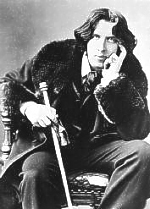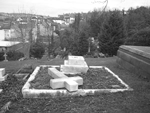


"The darkness grew intolerable" 1887 - 1895 *
According to a letter sent to his family in Estonia Eric was back in London by 1 July 1887. He arrived at just the wrong time
"...the Season was practically over and almost all of my acquaintances either gone away or on the point of going..."
and was terribly lonely. He did see Simeon Solomon regularly. But the painter was now persona non grata in society because of his convictions for public indecency and well into the decline which led to him to an early death in the St. Giles Workhouse. Though Eric seems to have helped support him financially he described him in the same letter as "the bane of my life."
In 1887 Eric rented a house at 11 Sloane Terrace in fashionable Belgravia. Byron had lived in the street as a child an it was an area known for its artists, bohemians and aristocrats. Little did he know the literary world was about to change.
 In
1887 Oscar Wilde accepted a job revitalising The Women's World magazine
and over the
next six years became one of the most celebrated and creative writers
of his era. He published two collections of children's
stories, The Happy Prince And Other Tales (1888), and The House Of Pomegranates
(1892). His novel, The Picture of Dorian Gray, was published
in 1891 to a storm of protest. Its
implied homoerotic theme was was considered immoral
and played a considerable part in his later legal trials. His first
play, Lady Windermere's Fan, opened in February 1892. Its financial and
critical success prompted him to continue to write for the theatre. His
subsequent plays included A Woman Of No Importance (1893),
In
1887 Oscar Wilde accepted a job revitalising The Women's World magazine
and over the
next six years became one of the most celebrated and creative writers
of his era. He published two collections of children's
stories, The Happy Prince And Other Tales (1888), and The House Of Pomegranates
(1892). His novel, The Picture of Dorian Gray, was published
in 1891 to a storm of protest. Its
implied homoerotic theme was was considered immoral
and played a considerable part in his later legal trials. His first
play, Lady Windermere's Fan, opened in February 1892. Its financial and
critical success prompted him to continue to write for the theatre. His
subsequent plays included A Woman Of No Importance (1893),
An Ideal Husband(1895), and The Importance Of Being Earnest (1895) were all highly acclaimed and firmly established Oscar as a playwright.
Though it is impossible to say if Eric was directly influenced by Wilde the fashion sense, social attitudes and position in society (a bohemian outsider) led to all similar writers being compared with him. As a group the artists, writers and composers who explored the themes, which would now be placed somewhere between social comment and magical realism, became known as the Decadents. Wilde's genius and notoriety was such that it was difficult for any others in the circle to be considered properly either at the time or since. In twentieth century terms it mirrors the position of The Rolling Stones whose position as Sixties Decadents has ousted all other groups in the same niche. (The Beatles of course were the equivalents of far more respectable parts of Victorian society.)
In 1890 Eric moved to 21 Gloucester Walk to be closer to his friends Adey and Robert Ross. It was because of this move he first met Norman O'Neill, then 16, in 1891, on the top of a Piccadilly horse bus. O'Neill, who was destined to become a composer of theatre music, was bright and beautiful. Eric was smitten. When O'Neill went to the Conservatory in Frankfurt Eric kept in touch sending him letters and drawings - a series of these letters still exist and Adlard includes extracts in his biography. But, although O'Neill became central to Eric's life his own biography contains little more than two pages about his earliest patron.
Rumours abounded about Eric's behaviour at the time but all were unconfirmed. He was certainly ill, as his letters to O'Neill show, and though he went to Venice in 1892 to recuperate he failed to benefit from the change of scenery. His letters at the time were distinctly melancholy and he expected imminent death.
In early 1893 he seemed to have recovered enough to re-enter society and was a regular at Aubrey Beardsley’s studio teas. There he conversed with many of the movers and shakers of society including Alymer Vallance art critic and friend of William Morris, Mrs Patrick Campbell, the publisher John Lane, and artist's Ricketts and Shannon. Eric often played the piano at these soirees and sang traditional Estonian folk songs.
On 2 June 1893 Eric made his will. After small bequests to his friends and family he left the residual of his estate to O'Neill. The property in Koln had already been passed to his cousins.
The winter of 1893/4 was the hardest in living memory. There were fierce storms and on 26 January a section of the cliff face at Brighton collapsed. Eric, now staying with his family in Brighton worked on his short story collection, Studies of Death, which was published in December 1894. But he was very ill and progress was slow.
On 26 April 1895 Eric was still at Withdeane. His increasingly eccentric bahaviour and violent outburst had made the Mowatt children somewhat afraid of him. Rumour says that on that Friday he flew into a rage and struck out at someone in the house with a poker. Overbalancing he hit his head on the grate and died. His death certificate is a little more prosaic listing 'Sepatic Cirrhosis' as the cause. There is no mention of a head injury and his half-sister Mary is listed as informant and as being present at the death.
 He
was buried on 1 May in Brighton's Extra Mural cemetery in what
Adlard says was a well attended service but which local papers
fail to mention. Before burial his heart was placed in a jar and
sent
to the family church
in
Estonia.
He
was buried on 1 May in Brighton's Extra Mural cemetery in what
Adlard says was a well attended service but which local papers
fail to mention. Before burial his heart was placed in a jar and
sent
to the family church
in
Estonia.
*From Sonnet
VIII
![]()



